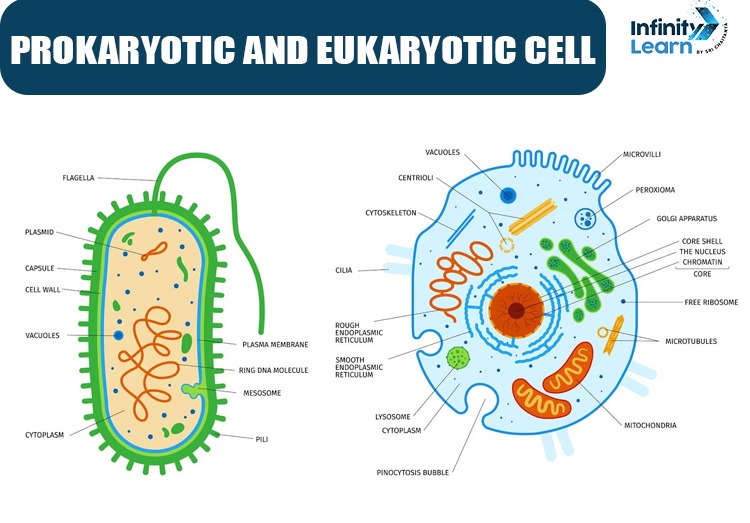
Courses

By Shailendra Singh
|
Updated on 28 Nov 2024, 12:37 IST
Diagram of Prokaryotic and Eukaryotic cell: Understanding the fundamental differences between prokaryotic and eukaryotic cells is crucial for studying biology. A clear and detailed diagram of prokaryotic and eukaryotic cells serves as an essential visual tool for distinguishing their structural features and functions. Prokaryotic cells, characterized by their simple structure and lack of a nucleus, contrast sharply with eukaryotic cells, which have a more complex organization with membrane-bound organelles.
A diagram of prokaryotic and eukaryotic cells visually illustrates the fundamental differences between these two major types of cells. Prokaryotic cells, found in bacteria and archaea, are characterized by the absence of a nucleus and membrane-bound organelles. Their cell structure includes a plasma membrane, cytoplasm, ribosomes, and a nucleoid region where genetic material resides. In contrast, eukaryotic cells, which make up plants, animals, fungi, and protists, possess a defined nucleus and various membrane-bound organelles such as mitochondria, endoplasmic reticulum, and Golgi apparatus. Understanding these cellular differences through detailed diagrams helps in grasping how cell functions and organismal complexities are organized. Exploring these diagrams provides insight into cell biology, highlighting how eukaryotic cells have evolved more complex structures compared to their prokaryotic counterparts.
Lets understand the Prokaryotic and Eukaryotic Cells in detail with their important features and components.
Prokaryotic cells are the simplest type of cells. They don’t have a nucleus or membrane-bound organelles. “Instead, their genetic material is not contained within a nucleus but is dispersed throughout the cell.” Bacteria and archaea are examples of prokaryotic cells. These cells typically exhibit a more compact and less complex structure in contrast to eukaryotic cells.
Key Features of Prokaryotic Cells:
Key Components of Prokaryotic Cells
1. Nucleoid Region: A region where the cell’s DNA resides. In prokaryotic cells, the genetic material resides in a distinct region called the nucleoid, unlike eukaryotic cells where it is enclosed within a nucleus.
Function: Contains genetic material responsible for guiding cell functions and reproduction.
2. Cell Membrane: A semi-permeable barrier that surrounds the cell.
Function: Regulates the movement of substances in and out of the cell, maintaining homeostasis.
3. Cell Wall: A rigid layer lying outside the cell membrane.
Function: Provides structural support and protection. In bacteria, this is primarily made of peptidoglycan.
4. Ribosomes: Description: Small structures floating freely in the cytoplasm.
Function: Synthesize proteins needed for cellular functions.
5. Flagellum: A long, whip-like structure.
Function: Facilitates movement, allowing the cell to swim through liquid environments.
Eukaryotic cells are considered more complex, featuring a nucleus and membrane-bound organelles. These cells are prevalent in organisms such as plants, animals, fungi, and protists. They typically exhibit larger sizes and possess diverse internal structures specialized for various biological functions.

Key Features of Eukaryotic Cells:
Key Components of Eukaryotic Cells
1. Nucleus: A membrane-bound organelle containing DNA.
Function: Controls cellular activities including growth, metabolism, and reproduction.
2. Cell Membrane: A lipid bilayer with embedded proteins.
Function: Maintains the cell’s integrity and regulates material exchange.
3. Cytoplasm: A gel-like substance within the cell membrane.
Function: Supports organelles and facilitates intracellular processes.
4. Mitochondria: Double-membraned organelles.
Function: Generate ATP through cellular respiration, providing energy for the cell.
5. Endoplasmic Reticulum: A network of membranes; rough (with ribosomes) and smooth (without ribosomes).
Function: Rough ER synthesizes proteins; Smooth ER synthesizes lipids and detoxifies substances.
6. Golgi Apparatus: Composed of a series of stacked, membrane-bound sacs.
Function: Responsible for modifying, sorting, and packaging proteins and lipids, preparing them for secretion or transport to other cell organelles.
7. Lysosomes: Small, membrane-bound vesicles filled with digestive enzymes.
Function: Essential for breaking down cellular waste and debris, ensuring efficient recycling of materials within the cell.
8. Vacuoles: Membrane-bound sacs, larger in plant cells.
Function: Store nutrients, waste products, and contribute to turgor pressure in plant cells.

| Feature | Prokaryotic Cells | Eukaryotic Cells |
|---|---|---|
| Cell Structure | Is Always unicellular | It Can be unicellular or multicellular |
| Cell Size | Typically 0.2 to 2.0 micrometers in diameter | Usually 10 to 100 micrometers in diameter |
| Cell Wall | Present and complex | Rarely present and simpler in structure |
| Nucleus | No true nucleus; DNA is in the nucleoid region | True nucleus present |
| DNA Shape | Circular DNA molecule | Linear DNA molecules |
| Cytoplasm | Contains cytoplasm but few organelles | Contains cytoplasm and various organelles |
| Mitochondria | Absent | Present; functions as the powerhouse of the cell |
| Ribosomes | Small, spherical | Larger, linear |
| Endoplasmic Reticulum & Lysosomes | Absent | Present |
| Plasmids | Commonly found | Rarely found |
| Cell Division | Occurs through binary fission | Occurs through mitosis |
| Flagella | Small, simple | Larger, more complex |
| Reproduction | Asexual reproduction only | Both sexual and asexual reproduction |
| Examples | Bacteria and Archaea | Plant and animal cells |
Also Refer: Difference Between Prokaryotic and Eukaryotic Cell in Detail

The nucleoid region is crucial because it contains the genetic instructions necessary for the cell’s functions and reproduction.
Yes, prokaryotic cells have a cell wall. It provides structural support and helps maintain shape, distinguishing them from eukaryotic cells which may or may not have a cell wall depending on the organism.
Prokaryotic and eukaryotic cells are connected through their fundamental roles as basic units of life. While they differ in complexity and internal structure, both types of cells share essential characteristics such as DNA as genetic material, cell membranes for boundary regulation, and the ability to carry out metabolic processes necessary for survival and growth. These commonalities underpin their connection as essential components of biological systems across all forms of life.
Prokaryotic cells replicate and divide through binary fission, where one cell divides into two identical daughter cells. Eukaryotic cells replicate through mitosis (for somatic cells), involving stages like DNA replication, nuclear division, and cytokinesis to create two new identical cells, or through meiosis (for gametes), resulting in cells with half the genetic material for sexual reproduction.
Most animal cells have lysosomes, but plant cells often have similar functions performed by other organelles like vacuoles.